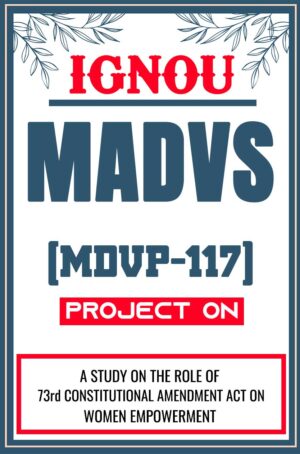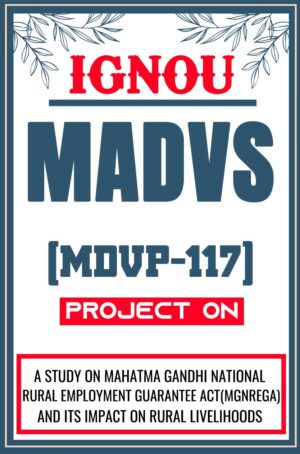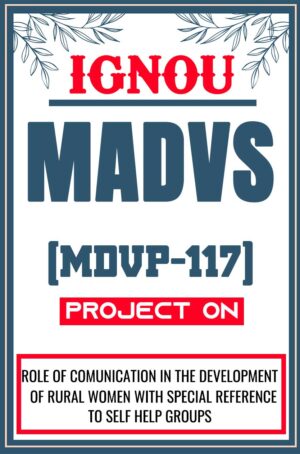Buy IGNOU MADVS Project for MDVP 117
The IGNOU MADVS (Master of Arts in Development Studies) project for MDVP 117 is an important part of the program since it allows students to gain hands-on experience conducting research on development topics. IGNOU MADVS Project is the course code for the project work, which is worth six credits. This project allows students to apply theoretical knowledge to real-world problems by doing in-depth investigation, data collection, analysis, and report writing.
Whatsapp us to get the Personalized (Customized) IGNOU MADVS Project Report and Synopsis
Download PDF Link for IGNOU MADVS Project (MDVP 117)
Students are expected to choose a development-related topic, which could include issues such as poverty, education, gender, environment, or rural development, as well as more particular themes based on their interests. The IGNOU MADVS Project entails defining a research problem, developing research questions or hypotheses, doing a literature study, deciding on an appropriate methodology, collecting and analyzing data, and lastly presenting the findings in a structured report.
How much time should you allocate for completing the IGNOU MADVS Project?
The time required to complete the MADVS Project can vary depending on several factors, including the complexity of the topic, your research skills, and how much time you can dedicate. However, a general guideline would be:
- Topic Selection and Proposal (2-4 weeks): Choose a relevant topic and develop a research proposal, including objectives, methodology, and a preliminary literature review.
- Literature Review (4-6 weeks): Conduct a thorough review of existing literature related to your topic to understand the current state of research and identify gaps.
- Data Collection (4-8 weeks): Depending on your methodology, collecting data might involve surveys, interviews, or fieldwork. Ensure you allocate enough time to gather sufficient data.
- Data Analysis (4-6 weeks): Analyze the collected data using appropriate statistical or qualitative methods. This step includes cleaning and preparing the data for analysis.
- Report Writing (4-6 weeks): Write and organize your research findings, discussion, and conclusions into a well-structured report. Include revisions and feedback from your supervisor.
- Review and Final Submission (2-4 weeks): Revise your report based on feedback, finalize the document, and prepare for submission. Ensure all formatting and citation guidelines are followed.
What are some common mistakes to avoid in data collection and analysis for your IGNOU MADVS Project?
When conducting data collection and analysis for a project like the MADVS Project, it’s important to avoid the following common mistakes:
- Poor Sampling Techniques: Using a non-representative sample or a sample that is too small can lead to biased results. Ensure your sample size is adequate and represents the population you are studying.
- Lack of Clear Objectives: Without clear research objectives, the data collected may not be relevant or useful. Be clear about what you want to achieve before starting data collection.
- Inadequate Data Collection Tools: Using inappropriate or poorly designed tools, such as questionnaires or surveys, can result in inaccurate data. Ensure your tools are well-designed and tested before use.
- Ignoring Data Validity and Reliability: Failing to assess the validity and reliability of your data collection methods can compromise the integrity of your research. Always validate your tools and methods.
- Bias in Data Collection: Personal biases, leading questions, or unintentional cues can skew data collection. Strive for neutrality and objectivity when collecting data.
- Data Entry Errors: Mistakes during data entry can lead to incorrect analysis. Double-check data entries and consider using software to minimize human error.
- Inappropriate Data Analysis Methods: Applying the wrong statistical methods or ignoring important variables can lead to misleading conclusions. Choose the right analysis techniques based on your data and research objectives.
- Overlooking Data Cleaning: Neglecting to clean your data by removing outliers, errors, or inconsistencies can distort analysis results. Always review and clean your data before analysis.
- Misinterpretation of Results: Drawing conclusions that are not supported by the data is a common mistake. Be cautious in interpreting results and ensure your conclusions are based on solid evidence.
- Neglecting Ethical Considerations: Failing to obtain informed consent, maintain confidentiality, or address ethical concerns can compromise your research’s credibility and validity. Always adhere to ethical guidelines in data collection and analysis.
Samples of IGNOU MADVS Project topics for MDVP 117
- Role of Rural Banks in the Empowerment of Farmers
- Role of Non-Government Organizations (NGOs) in Educating and Empowering Women
- Role of Communication For the Development of Rural Women With Special Reference to Self-help Group
- A Study on Mahatma Gandhi National Rural Employment Guarantee Act (MGNREGA) and Its impact on Rural livelihoods
- A Study on the Role of the 73rd Constitutional Amendment Act on Women empowerment
- Women’s Empowerment in Panchayati Raj Institution
How do you ensure your IGNOU MADVS Project report is well-written and informative?
To ensure your project report is well-written and informative, follow these key steps:
Clearly Define Objectives:
- Start with a clear statement of your research objectives and questions. This will guide your entire report and ensure all sections are relevant.
Structure Your Report:
- Organize your report into standard sections—Introduction, Literature Review, Methodology, Results, Discussion, Conclusion, and References. Use headings and subheadings to make it easy to navigate.
Write a Strong Introduction:
- Clearly outline the problem or question your research addresses, its significance, and your research objectives. Provide a brief overview of the structure of your report.
Conduct a Thorough Literature Review:
- Summarize and analyze relevant research to provide context and background for your study. Highlight gaps that your research addresses.
Detail Your Methodology:
- Describe your research design, data collection methods, and analysis techniques. Be transparent about how you collected and analyzed data.
Present Results Clearly:
- Use tables, graphs, and charts to present data in a clear and concise manner. Accompany visuals with explanatory text to ensure they are understandable.
Interpret Your Findings:
- In the Discussion section, interpret the results, explain their implications, and how they relate to your research questions. Discuss any limitations and suggest areas for future research.
Conclude Effectively:
- Summarize the key findings of your research and their significance. Provide a clear and concise conclusion that ties back to your research objectives.
Ensure Proper Referencing:
- Cite all sources correctly using a consistent referencing style. Include a comprehensive bibliography or reference list.
Proofread and Edit:
- Review your report multiple times to correct grammatical errors, improve clarity, and ensure coherence. Consider getting feedback from peers or your supervisor.
Follow Formatting Guidelines:
- Adhere to any specific formatting and presentation guidelines provided by IGNOU. Ensure consistency in font, margins, and citation style.
Use Professional Language:
- Write in a formal, academic style. Avoid jargon unless necessary, and explain any technical terms used.
What are the criteria used to assess the quality of the IGNOU MADVS Project?
The quality of a project report for the MADVS Project is assessed based on several key criteria:
- Clarity of Research Objectives: The report should clearly state the research problem or objectives and their significance. The objectives should be specific, measurable, and relevant to the study.
- Literature Review: A thorough and critical review of existing literature should be presented. It should identify gaps in the research and demonstrate how your study contributes to the field.
- Methodology: The methodology section should be detailed and appropriate for the research question. It should include a clear explanation of research design, data collection methods, and analysis techniques.
- Data Collection and Analysis: The report should demonstrate that data was collected systematically and analyzed accurately. The analysis should be appropriate for the data type and research objectives.
- Results Presentation: Results should be presented clearly, with the use of tables, charts, or graphs where appropriate. They should be directly linked to the research objectives and questions.
- Discussion and Interpretation: The discussion should interpret the results in the context of the literature review, explaining their implications and relevance. It should also address limitations and suggest areas for further research.
- Conclusion: The conclusion should summarize key findings and their significance. It should effectively link back to the research objectives and provide a clear summary of the study’s contributions.
- Structure and Organization: The report should be well-organized, with a logical flow of sections and a clear structure. Headings and subheadings should be used effectively to guide the reader.
- Writing Quality: The writing should be clear, concise, and free of grammatical errors. The language should be formal and suitable for academic writing.
- Referencing and Citations: Proper and consistent referencing of sources is crucial. The report should follow a recognized citation style and include a comprehensive reference list.
- Originality and Contribution: The project should demonstrate originality in its approach or findings and contribute valuable insights to the field of development studies.
- Adherence to Guidelines: The report should adhere to any specific formatting, length, and submission guidelines provided by IGNOU.
Can you collaborate with other students on your IGNOU MADVS Project?
For the MADVS Project, the project is generally expected to be an individual endeavor. The focus is on demonstrating your individual research skills and understanding of the subject matter. Here’s what you should consider:
Individual Work:
- Most academic projects, including those in IGNOU, are designed to be completed individually to showcase your personal research and analytical abilities.
Group Work Policies:
- Check the specific guidelines provided by IGNOU for the MADVS Project. Some programs may allow or even encourage collaborative work under certain conditions, but this is not always the case.
Consult Your Supervisor:
- If you are interested in collaboration, discuss it with your project supervisor or academic advisor. They can provide guidance on whether collaboration is permitted and how it should be managed if allowed.
Roles and Responsibilities:
- If collaboration is permitted, clearly define each person’s role and responsibilities to avoid overlaps and ensure all aspects of the project are covered effectively.
Academic Integrity:
- Ensure that all collaborative work adheres to academic integrity standards. Properly acknowledge contributions and avoid any issues related to plagiarism or misattribution.
Project Requirements:
- Make sure that any collaborative approach meets the specific requirements and evaluation criteria set for the project.
What are the key points to highlight in your presentation of your IGNOU MADVS Project?
For an effective presentation of your MADVS Project, focus on the following key points:
Introduction:
- Research Problem: Clearly state the problem or question your project addresses.
- Objectives: Outline the specific aims of your research.
- Significance: Explain why your research is important and its potential impact.
Literature Review:
- Background: Summarize the key findings from your literature review.
- Gaps Identified: Highlight any gaps in existing research that your project addresses.
Methodology:
- Research Design: Describe the overall design of your study (e.g., qualitative, quantitative, mixed methods).
- Data Collection: Explain how and where you collected your data.
- Analysis Techniques: Outline the methods you used to analyze your data.
Results:
- Key Findings: Present the main results of your research. Use visual aids such as charts or graphs to make the data more accessible.
- Patterns or Trends: Highlight any significant patterns or trends identified in the data.
Discussion:
- Interpretation: Discuss what your findings mean in the context of your research objectives and literature review.
- Implications: Explain the implications of your findings for the field of development studies or your specific research area.
Conclusion:
- Summary: Summarize the key findings and their relevance.
- Recommendations: Offer any recommendations based on your research.
- Future Research: Suggest areas for further study or research.
Visuals and Data Presentation:
- Clarity: Ensure your slides or visual aids are clear, professional, and not overloaded with text.
- Relevance: Use visuals to support and enhance your points rather than to distract.
Q&A Preparation:
- Anticipate Questions: Be prepared to answer questions about your research methods, findings, and conclusions.
- Practice Responses: Practice answering potential questions to improve your confidence and clarity.
Timing:
- Conciseness: Keep your presentation within the allotted time. Practice to ensure you can cover all key points efficiently.
Professionalism:
- Engagement: Engage your audience with a clear and confident delivery.
- Language: Use professional and academic language suitable for your audience.
Ready to get your IGNOU MADVS Project Report and Synopsis Sample PDF for MDVP 117?
- Call us or WhatsApp us at: 9958947060, 9354637830
- Visit: SHRICHAKRADHAR.COM
- Note: Please keep in mind that these are ready-made sample MADVS Project Report and MADVS Synopsis for students to learn how to create a MADVS synopsis and MADVS project report. Many students may be interested in purchasing them. Because IGNOU does not accept repeated projects, there will be a chance of rejecting these projects.
-
Sale!

-
Sale!

IGNOU MADVS Project (MDVP-117) Synopsis/Proposal & Project Report/Dissertation in Hard-Copy (Sample-5)
Original price was: ₹499.00.₹249.00Current price is: ₹249.00. -
Sale!

IGNOU MADVS Project (MDVP-117) Synopsis/Proposal & Project Report/Dissertation in Hard-Copy (Sample-4)
Original price was: ₹499.00.₹249.00Current price is: ₹249.00. -
Sale!

IGNOU MADVS Project (MDVP-117) Synopsis/Proposal & Project Report/Dissertation in Hard-Copy (Sample-3)
Original price was: ₹499.00.₹249.00Current price is: ₹249.00. -
Sale!

IGNOU MADVS Project (MDVP-117) Synopsis/Proposal & Project Report/Dissertation in Hard-Copy (Sample-2)
Original price was: ₹499.00.₹249.00Current price is: ₹249.00. -
Sale!

IGNOU MADVS Project (MDVP-117) Synopsis/Proposal & Project Report/Dissertation in Hard-Copy (Sample-1)
Original price was: ₹499.00.₹249.00Current price is: ₹249.00.
